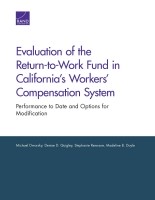| 来源类型 | Research Reports
|
| 规范类型 | 报告
|
| DOI | https://doi.org/10.7249/RR2548
|
| ISBN | 9781977400970
|
| 来源ID | RR-2548-DIR
|
| Evaluation of the Return-to-Work Fund in California's Workers' Compensation System: Performance to Date and Options for Modification |
| Michael Dworsky; Denise D. Quigley; Stephanie Rennane; Madeline B. Doyle
|
| 发表日期 | 2018
|
| 出版者 | RAND Corporation
|
| 出版年 | 2018
|
| 页码 | 180
|
| 语种 | 英语
|
| 结论 |
The program is working as intended- The RTWSP has been successfully targeted to workers with more-severe disabilities.
- Program administration is efficient and rapid, with little evidence of fraud or abuse.
- The RTWSP is paid to workers in a timely manner after application: 90 percent of successful applicants are paid the RTW Supplement within three weeks of applying.
- The vast majority of applicants ultimately receive the RTW Supplement: The ultimate acceptance rate among applicants is 96 percent.
But take-up rates can be improved, and workers without legal representation were unlikely to apply- Despite the efficiency of the application process, just over half of eligible workers apply for the RTWSP.
- Legal representation is the factor most strongly associated with take-up of the RTWSP among eligible workers. After controlling for a wide range of other factors, eligible workers with legal representation were more than 40 percentage points more likely to apply for the RTWSP than comparable eligible workers without representation were. This suggests that many workers are failing to navigate the process on their own.
- Hypothesized barriers to access, such as language or geography, were not as important as legal representation in determining which eligible workers applied for the RTWSP.
- The eligible population for the program is larger than expected when the program was established, and increasing receipt of the SJDB voucher may contribute to continued eligibility growth.
|
| 摘要 |
- DIR could develop a system to make disbursement of the RTW Supplement automatic upon notification that a worker has received an SJDB voucher.
- If the RTW Supplement is not made automatic, DIR could make changes to outreach and notification processes to help increase take-up of the RTWSP by eligible workers. Relatively minor changes to the content and formatting of the SJDB voucher notification might improve workers' awareness of the RTWSP and their understanding that the RTW Supplement is a readily available $5,000 cash payment.
- Treating physicians do not always complete the forms necessary for workers to receive the SJDB and thus become eligible for the RTWSP. Targeted efforts to educate physicians about their reporting responsibilities could also improve workers' access to the RTW Supplement.
- Whether or not DIR decides to make the RTWSP automatic, the authors strongly recommend that DIR collect information from claims administrators about the issuance of SJDB vouchers, either on a systemwide or a representative basis.
|
| 主题 | California
; Program Evaluation
; Return-to-Work Programs and Policies
; Workers' Compensation
|
| URL | https://www.rand.org/pubs/research_reports/RR2548.html
|
| 来源智库 | RAND Corporation (United States)
|
| 引用统计 |
|
| 资源类型 | 智库出版物
|
| 条目标识符 | http://119.78.100.153/handle/2XGU8XDN/108792
|
推荐引用方式
GB/T 7714 |
Michael Dworsky,Denise D. Quigley,Stephanie Rennane,et al. Evaluation of the Return-to-Work Fund in California's Workers' Compensation System: Performance to Date and Options for Modification. 2018.
|
|
文件名:
|
x1529501824410.jpg
|
|
格式:
|
JPEG
|

|
文件名:
|
RAND_RR2548.pdf
|
|
格式:
|
Adobe PDF
|
除非特别说明,本系统中所有内容都受版权保护,并保留所有权利。